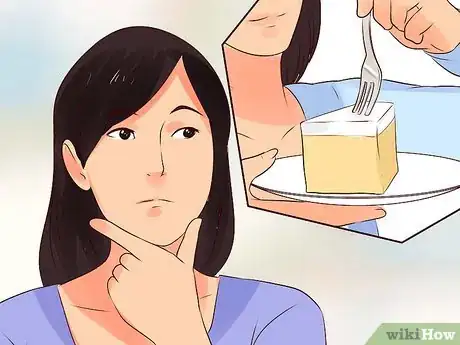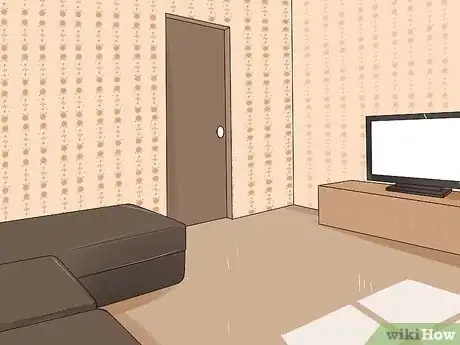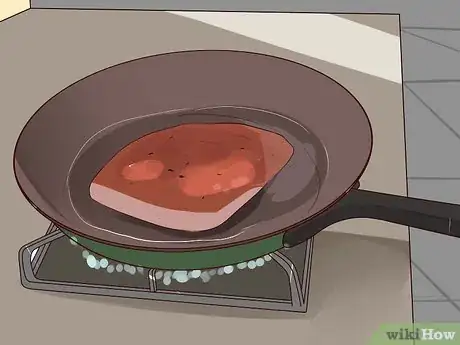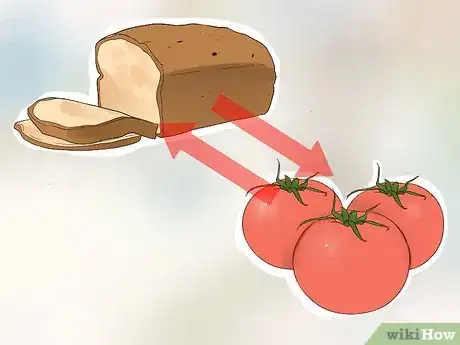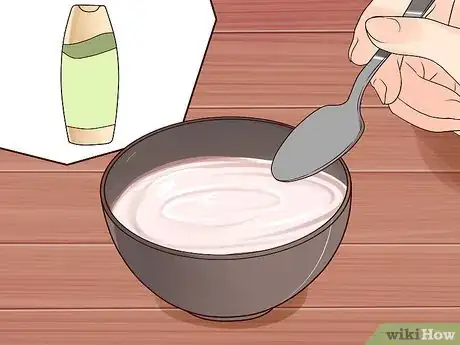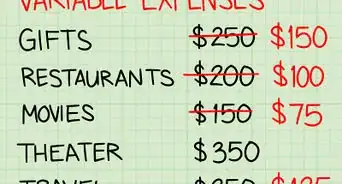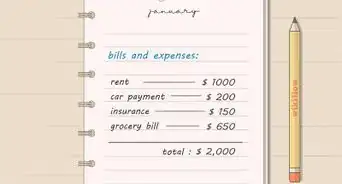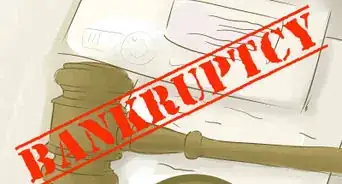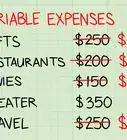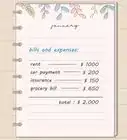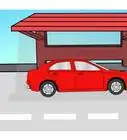X
wikiHow is a “wiki,” similar to Wikipedia, which means that many of our articles are co-written by multiple authors. To create this article, 81 people, some anonymous, worked to edit and improve it over time.
There are 14 references cited in this article, which can be found at the bottom of the page.
This article has been viewed 634,515 times.
Learn more...
The proposition to “buy nothing” can seem daunting and difficult to achieve. But buying nothing, even for a year, can save you thousands of dollars and make you more spending conscious.[1] Start with simple adjustments to your lifestyle and your budget to transition into buying nothing for a long period of time, possibly forever.
Steps
Method 1
Method 1 of 2:
Adjusting Your Budget
-
1Determine the sources of your spending. Sit down with a pen and paper, or with a blank text document on your computer and think about how much you spend each month on:[2]
- Living expenses (rent, mortgage)
- Transportation (car insurance/maintenance, gas, bus fare)
- Food (groceries every week/month)
- Utilities (electricity, heating)
- Cellphone, internet
- Going out (drinks after work, with friends, or special meals)
- Be as detailed as possible. Focus on how many times a week you go out for lunch or dinner, or buy a coffee. Add up a rough amount for each category. Are you overspending on your food expenses? The average household spends $500 a month on groceries. Are you overspending on going out for drinks or on extra activities (like the gym membership you never use)?
-
2Figure out what you can cut from your current budget. Determine where you can start to spend nothing. Start with the more leisurely expenses first, like going out with friends, or spending money on clothing.[3]
- Think about your eating habits. Is there a way to reduce your food costs so you’re only buying essential foods or using pantry foods you already own?
- Consider your transportation costs. Can you reduce or remove your car expenses by using your car less or using a bike or walking? Though it may be difficult to imagine life without a car, think about how much you spend every month on this expense, especially on gas.
Advertisement -
3Enlist the support of a friend or partner. Many people who have tried Buy Nothing experiments for a year, or who have participated in the Buy Nothing project adjust their lifestyle with a partner, spouse, roommate, or as part of a larger group. Doing this challenge with one other person can motivate you to stick to your limited means and have fun buying nothing.[4]
-
4Track your progress and your lack of spending. Now that you have isolated leisure spending you can reduce or cut from your budget, track your lower spending for a month. Start a blog about your Buy Nothing project, or take notes in a journal. Note how much money you save just by cutting out leisure expenses and activities. Now, multiply this amount by 12 to determine how much you could save in one year without these expenses. Consider this amount your buy nothing goal.[7]
- There is a theory that it take 30 days to change a habit or adopt a new habit. After a month of lower to no spending on certain items or activities, you should start to notice you perceive items in a store or socialize at a restaurant or bar differently. You may start asking yourself, “Do I really need this?” before you buy something. More often than not, the answer will be “No”.[8]
Advertisement
Method 2
Method 2 of 2:
Adjusting Your Lifestyle
-
1Learn to live rent-free. One of the most difficult things to eliminate from your budget is likely rent, or the cost of your living space. There are several possible ways to live without paying for rent or for a home, including:
- Moving into an unoccupied home. Some cities or areas have vacant dwellings that need some attention and care. A landlord may be willing to allow you to live rent free in a vacant home in exchange for fixing and upkeeping the home. You should inspect the home to determine how extensive the damage is to the foundation and structure. Look for a home you can maintain with a few basic tools and some hard work. Once it’s in living order, you can now occupy it, rent free.[9]
- House sitting. When homeowners go away for extended periods of time, they look for trusted individuals to occupy and maintain their homes. In addition to house duties, and sometimes pet duties, you will be paid an hourly wage to take care of the property, ranging from $15/hr to a fixed monthly rate for longer jobs. Look for house sitting opportunities online[10] , and always sign a contract before taking on a house sitting job.[11]
- Apartment management. You could also become a landlord yourself, where you get free rent in exchange for maintaining the building and responding to the needs of the building’s tenants. However, this could be a big responsibility in terms of time and energy.[12]
- Moving in with your parents. Though you may not want to end up staying with your parents past high school, many graduates and young adults move back in with their parents to save money on rent and food. A zero rent, home cooked meal situation may not be so bad, and will bring you one step closer to buying nothing.[13]
-
2Make a list of items you already own or can borrow. Cut down on the need to buy any new items by thinking about the things you already own. This could be items of clothing, bottles of unused cleaning products, or stacks of goods that have been gathering dust in your garage.
- Trade or borrow items by having a clothing swap or item swap with friends. Search for items online on sites like Freecycle.[14] . These sites list items people are giving away for free or for trade.
-
3Walk or bike, instead of driving. Challenge yourself to buy no gas for a month and walk or bike everywhere instead. This may mean a longer morning commute to work or being able to only do two or three errands a day instead of six or seven. But you will saving money and getting physically fit throughout your day.[15]
-
4Prepare your own meals. A big part of buying nothing is avoiding eating out and spending money on food. Focus on creating a meal plan every week where you use pantry items you already own and vegetables from a local garden or your own backyard garden.[16]
- Many people who commit to a buy nothing lifestyle invest in an aquaponics system, where fish help to fertilize a garden that can grow enough produce for one person. Aquaponic systems are self-sufficient and require minimal upkeep. They can also produce a variety of produce, from herbs to tomatoes, peppers, lettuce, and other greens. Over time, this system will provide you with a free food source.[17]
- There are several budget friendly food blogs and books with recipes that cost less than $10 to prepare and use pantry items you may already own.[18]
-
5Look for free meal opportunities. Soup kitchens and food banks provide free meals to people daily. There are also other practices, like dumpster diving, or food bartering, that require no money and can lead to some free food.
- Dumpster diving is when you look in dumpsters and trash bins for items that may be edible, useful, or recyclable. Dumpster diving can also be profitable, as you can sell any valuable items you find in the garbage. However, you must always wear full body protection when dumpster diving and have a strong stomach for potentially gross discoveries, such as dead animals, hazardous weapons, and biohazardous items like used needles.[19]
- Food bartering is when you trade one food item for another food item. For example, you may have a surplus of tomatoes in your garden, or too many loaves of homemade bread in your kitchen. You would then network with other people in your area to barter for other food. There are several food bartering groups on Facebook and online. Search for food bartering networks in your area.
-
6Learn to DIY (Do It Yourself). From home repairs to bike repairs to fixing old household items, doing it yourself means you do not need to pay someone for a service or task. Doing repairs or redecorating yourself also fills your time with activities that contribute to your buy nothing lifestyle, rather than put you in position where you may be tempted to spend money.[20]
- There are many websites devoted to do it yourself projects that require a minimal skill level, with a variety of projects you can try on your own.[21]
-
7Make your own household products. Items like laundry detergent, toothpaste, deodorant, face wash, and soap can be made at home with a few basic pantry items. This is another great way to fill your time with an activity that leads to less spending and useful items around the house.
-
8Look for free events and outings. Most large cities have free events every month to celebrate holidays. Check out the listings in your local paper to find out if any free festivals or special events are going on in your area.
- Activities like hiking or walking in a local park or on local trails, as well as biking to remote destinations or areas, are all great ways to get out, have fun, and buy nothing.
-
9Note your progress on a blog or a journal. Buying nothing will save you money and give you a new perspective on spending. But it can also be lonely and isolating when you cannot go out with friends for drinks or buy presents for someone’s birthday. Starting a blog about your attempt to buy nothing will connect you with a community of others who are interested in your lifestyle or are currently trying the buy nothing lifestyle themselves. It may also give you encouragement and support to eliminating your spending habits.[22]
- Search on the Buy Nothing Project website[23] to connect with others who are also involved in the movement to buy nothing.
Advertisement
Community Q&A
-
QuestionHow does one live this lifestyle for very long without feeling a yawning abyss of inadequacy overtake them?
 Community AnswerIf you feel inadequate because others around you are buying new things constantly and participating in unnecessary materialism, try to remember you are doing this for yourself and no one else can decide what is right for you and how to live.
Community AnswerIf you feel inadequate because others around you are buying new things constantly and participating in unnecessary materialism, try to remember you are doing this for yourself and no one else can decide what is right for you and how to live. -
QuestionHow can I spend time doing nothing?
 Community AnswerCheck out the helpful tips in this article about how to do nothing on wikiHow.
Community AnswerCheck out the helpful tips in this article about how to do nothing on wikiHow. -
QuestionIs this possible if I have a dog? If so, how do I do this?
 Community AnswerNot really, dogs and most other pets, need medical care and prevention that is quite costly. That being said, if you're determined to do it, plenty of homeless people keep dogs, they just feed them out of dumpsters or rely on donations, etc.
Community AnswerNot really, dogs and most other pets, need medical care and prevention that is quite costly. That being said, if you're determined to do it, plenty of homeless people keep dogs, they just feed them out of dumpsters or rely on donations, etc.
Advertisement
References
- ↑ http://www.forbes.com/sites/laurashin/2014/08/20/the-buy-nothing-year-how-two-roommates-saved-more-than-55000/3/
- ↑ http://www.forbes.com/pictures/fjfi45hhdd/1-reconcile-your-accounts-monthly/
- ↑ http://www.forbes.com/pictures/fjfi45hhdd/1-reconcile-your-accounts-monthly/
- ↑ http://www.forbes.com/pictures/fjfi45hhdd/1-reconcile-your-accounts-monthly/
- ↑ http://buynothingproject.org/
- ↑ http://www.forbes.com/sites/laurashin/2014/08/20/the-buy-nothing-year-how-two-roommates-saved-more-than-55000/3/
- ↑ http://news.nationalpost.com/news/canada/buy-almost-nothing-year-comes-to-an-end-for-pair-of-calgarians-who-say-they-saved-upwards-of-40k-each
- ↑ http://news.nationalpost.com/news/canada/buy-almost-nothing-year-comes-to-an-end-for-pair-of-calgarians-who-say-they-saved-upwards-of-40k-each
- ↑ http://www.motherearthnews.com/homesteading-and-livestock/how-to-live-rent-free-zmaz77zbon.aspx
- ↑ https://www.housecarers.com/
- ↑ http://www.kiplinger.com/article/real-estate/T063-C006-S001-yes-you-can-live-rent-free.html
- ↑ http://www.kiplinger.com/article/real-estate/T063-C006-S001-yes-you-can-live-rent-free.html
- ↑ http://www.kiplinger.com/article/real-estate/T063-C006-S001-yes-you-can-live-rent-free.html
- ↑ https://www.freecycle.org/
- ↑ http://www.bankrate.com/finance/personal-finance/jump-start-savings-with-no-spend-month-1.aspx
- ↑ http://www.forbes.com/pictures/fjfi45hhdd/4-cook-at-home/
- ↑ http://news.nationalpost.com/news/canada/buy-almost-nothing-year-comes-to-an-end-for-pair-of-calgarians-who-say-they-saved-upwards-of-40k-each
- ↑ http://www.huffingtonpost.com/2014/11/11/budget-food-blogs_n_6135100.html
- ↑ http://www.allthingsfrugal.com/dumpster.htm
- ↑ http://www.forbes.com/pictures/fjfi45hhdd/2-learn-to-diy/
- ↑ http://www.diynetwork.com/
- ↑ http://www.forbes.com/sites/laurashin/2014/08/20/the-buy-nothing-year-how-two-roommates-saved-more-than-55000/3/
- ↑ http://buynothingproject.org/
About This Article
Advertisement

